9- The ING Forms
9- The ING Forms
We add -ing to continuous verb forms and gerunds
Examples
She is in her bedroom. She is doing her homework
I like fishing
If you are in a hurry, here is a summary of 9 rules to help you with the ing form spelling. If you need detailed explanations, continue reading after this summary of the rules
When adding the “-ing”, we have to follow special spelling rules
The general rule is to add -ing to the verb. For example, for verbs like wait, visit, speak, add only -ing (i.e., waiting; visiting, speaking.)
When a verb ends in a silent e, we drop the e and add -ing. For example, close becomes closing
For verbs with one syllable and ending in a vowel and a consonant (e.g., run, stop, hit), double the final consonant and add -ing. For example, hit becomes hitting
For verbs ending in w, y, or, x, we only add -ing. For example, fix becomes fixing
For verbs ending in a vowel and a consonant with the stress on the final syllable (e.g., refer, forget, happen), double the consonant and add -ing (e.g., referring, forgetting, happenning.)
For verbs ending in -ie, drop the -ie and add –ying. For example, die becomes dying
For verbs ending in –ee, –ye, and –oe, do not remove the final –e when adding -ing. For exmple, the verbs free, dye, and tiptoe, become freeing, dyeing, and tiptoeing
For verbs ending in a consonant + vowel + L, one of 2 rules apply depending on whether you are using American or British English. In American English, travel becomes traveling while in British English it becomes travelling
For verbs ending in -c , we add a -k + -ing. For example, mimic becomes mimicking when we add -ing
?What are the ing spelling rules
The spelling rules that govern the formation of continuous verbs and gerunds may be confusing. The spelling changes according to verb endings and the number of syllables. The following sections present nine spelling rules to master the spelling of ing forms
General rule
The general rule is to add -ing to the verb. To illustrate, for verbs like
visit, watch, sing, do, wait, work…
add -ing to the verb
Examples
Working on the computer can cause eyesight problems
I am working on a new project
| do | + | ing | doing |
| go | going | ||
| eat | eating | ||
| look | looking | ||
| read | reading | ||
| sing | singing | ||
| speak | speaking | ||
| visit | visiting | ||
| wait | waiting | ||
| watch | watching | ||
| work | working |
Verb Forms Dictionary
When a verb ends in a silent e, we drop the e and add -ing
Making tea is not difficult
Nancy is in the kitchen. She is making tea
| close | + | ing | closing |
| take | taking | ||
| hate | hating | ||
| love | loving | ||
| dine | dining | ||
| make | making | ||
| move | moving | ||
| create | creating | ||
| write | writing |
One-syllable verbs ending in a vowel and a consonant
For verbs with one syllable and ending in a vowel and a consonant (e.g., run, stop, hit), double the final consonant and add -ing
Examples
Running early in the morning makes me feel happy
Look at that woman. She is running as fast as she can
| cut | + | ing | cutting |
| hit | hitting | ||
| run | running | ||
| sit | sitting | ||
| sob | sobbing | ||
| stop | stopping | ||
| swim | swimming | ||
| tap | tapping | ||
| win | winning |
Verbs ending in w, y, or, x, we only add -ing
For verbs ending in w, y, or, x, we only add -ing
Examples
Fixing this computer is easy
They are fixing my computer
| bow | + | ing | bowing |
| fix | fixing | ||
| know | knowing | ||
| lay | laying | ||
| mix | mixing | ||
| pay | paying | ||
| say | saying | ||
| snow | snowing |
Verbs ending in a vowel and a consonant with stress on the final syllable
For verbs ending in a vowel and a consonant with stress on the final syllable (e.g., refer, forget, happen), we double the consonant and add -ing
Examples
Referring to my article was nice of him
?Are you referring to this car or that one
| admit | + | ing | admitting |
| begin | beginning | ||
| forget | forgetting | ||
| happen | happening | ||
| prefer | preferring | ||
| refer | referring | ||
| regret | regretting | ||
| submit | submitting | ||
| upset | upsetting |
Verbs ending in -ie
For verbs ending in -ie, drop the -ie and add –ing
Examples
Lying to me was not kind of him
Listen! He is lying to us again
| die | + | ing | dying |
| lie | lying | ||
| tie | tying | ||
| vie | vying |
Verbs ending in –ee, –ye, and –oe
For verbs ending in –ee, –ye, and –oe, do not remove the final –e when adding -ing
| free | + | ing | freeing |
| dye | dyeing | ||
| hoe | hoeing | ||
| tiptoe | tiptoeing |
Verbs ending in consonant + vowel + L
For Verbs ending in consonant + vowel + L, two rules apply depending on whether you are using American or British English. In American English, the final L is not doubled, but in British English, it is doubled
Examples
Traveling/Travelling to Paris is my dream
They are traveling/travelling to Paris next month
| distill | + | ing | distilling (UK) | distiling (US) |
| equal | equalling (UK) | equaling (US) | ||
| quarrel | quarrelling (UK) | quarreling (US) | ||
| travel | travelling (UK) | traveling (US) |
Verbs ending in -c
For verbs ending in -c , we add a -k + -ing
Examples
Mimicking my brother is a lot of fun
He is mimicking his brother
| frolic | + | ing | frolicking |
| panic | panicking | ||
| mimic | mimicking | ||
| traffic | traficking |
ING Spelling Rules
To write a verb ending in -ING you need to know the correct spelling
General Rule
In general you just add -ING to the end of a verb.
| Infinitive | ING form |
| to eat | eating |
| to go | going |
| to look | looking |
| to read | reading |
I am eating
They are going to the beach
He is looking at the painting
She is reading a book
BUT there are some exceptions
-ING Spelling Exceptions
Verbs ending in Consonant + E
When a word ends in consonant + E, we remove the E from the end and add ING
| Infinitive | ING form |
| to dance | dancing |
| to make | making |
| to ride | riding |
| to write | writing |
She is dancing
I am making a sandwich
He is riding his bike
Susan is writing a letter
Verbs ending in IE
But when a word ends in I + E, we remove the IE from the end and add YING
| Infinitive | ING form |
| to die | dying |
| to lie | lying |
| to tie | tying |
Many people are dying from the virus
I know you are lying to me
He is tying his laces
Verbs with one syllable ending in consonant + vowel + consonant
When a verb with one syllable ends in consonant + vowel + consonant, we double (make two of) the final consonant and add ING
| Infinitive | ING form |
| to cut | cutting |
| to run | running |
| to sit | sitting |
| to stop | stopping |
| to swim | swimming |
He is cutting an onion
They are running in the park
We are sitting on our chairs
The policeman is stopping the traffic
She is swimming in the pool
Verbs ending in W or X or Y
When a word ends in a W, X or Y, we do NOT double that final letter before add ING. Notice how there is a vowel before each letter
| Infinitive | ING form |
| to enjoy | enjoying |
| to fix | fixing |
| to follow | following |
| to play | playing |
| to snow | snowing |
?Are you enjoying the party
The mechanic is fixing the car
I think someone is following
He is playing with his marbles
It is snowing right now
Last syllable NOT stressed
When a verb has two or more syllables and the last syllable is NOT stressed, we do NOT double the final letter before adding ING
The verb OPEN has two syllables…. O + PEN
Since the first syllable is stressed (O-pen) and not the last syllable (we do not say o-PEN), we do not double the final N
So we just add ING to the end and it now becomes OPENING
Here are some more examples. Listen to how the last syllable of each verb is NOT stressed. Usually the first syllable is stressed
| Infinitive | ING form |
| to happen | happening |
| to listen | listening |
| to offer | offering |
| to open | opening |
| to visit | visiting |
| to whisper | whispering |
?What is happening right now
I am listening to the radio
My boss is offering me a new position
They are opening their presents
They are visiting the museum
They are whispering because the baby is asleep
EXCEPTION
The verb kidnap is an exception to this rule. The first syllable has the stress (KID-nap) we for this word we do double the final P
Kidnap -> kidnapping
C+V+C Last syllable IS stressed
When a verb has two or more syllables and ends in a consonant + vowel + consonant and the last syllable IS stressed, we double the final consonant before adding ING
The verb BEGIN has two syllables…. BE + GIN
Since the last syllable is stressed (be-GIN) and not the first syllable (we do not say BE-gin), we double the final N
So we just add an extra N before ING and it now becomes BEGINNING
Here are some more examples. Listen to how the last syllable of each verb IS stressed
| Infinitive | ING form |
| to admit | admitting |
| to begin | beginning |
| to forget | forgetting |
| to refer | referring |
| to submit | submitting |
| to upset | upsetting |
Admitting your mistake was a brave thing to do
She’s beginning to feel tired
I’m sure I am forgetting
?Are you referring to this one or that one
He is submitting a new proposal
I’m sorry for upsetting
You can see we only double consonants in stressed syllables
Verbs ending in consonant + vowel + L
There are two ways of spelling a verb ending in a consonant + vowel + L
In BRITISH English, you double the final L
In AMERICAN English, you do NOT double the final L unless it is stressed
The first syllable of the verb travel is stressed (TRA-vel)
The last syllable of the verb control is stressed (con-TROL)
| Infinitive | ING form (British English) | ING form (American English) |
| to equal | equalling | equaling |
| to travel | travelling | traveling |
| to control | controlling | controlling * |
* Notice how there is a double L in controlling in American English. That is because the last syllable of the verb control is stressed (con-TROL)
Sales are currently equalling those the same time last year
There were travelling around Europe until the virus stopped everything
They are now controlling the company
Spelling Rule -ING
What is the rule when adding ‘ing’ to a word
Here is how you can correct ” -ing forms” spellings of gerunds and verbs
We can change a verb into ‘ing’ form by adding ‘ing’ at the end of verb
| Base form | ING form |
| Deal | dealing |
| Show | showing |
| Weep | weeping |
| Do | doing |
| Talk | talking |
| Hear | hearing |
| Post | posting |
Examples
He is dealing with the hardships of life
He was doing the work efficiently
Who is talking with you
Tom is showing us his new car
The child is weeping
If there comes ‘e’ at the end of verb, then add ‘ing’ at the end of verb by removing ‘e
| Base form | ING form |
| Smile | smiling |
| Write | writing |
| Make | making |
| Ride | riding |
| Shine | shining |
Some examples of above rule
She is smiling while watching TV
The chef is making a sponge cake
The stars are shining at the sky
Tom is riding the horse
He is writing an essay
If the composition of verb is Consonant+Vowel+Consonant, then the final consonant is doubled + ‘ing’ at the en
| Infinitive | ING form |
| Ban | banning |
| Bet | betting |
| Grit | gritting |
| Get | getting |
The government was banning the use of polythene bags
They were gritting the icy-way
He is getting admission in Beacon House School
If a two-syllable verb ends in a Consonant + Vowel + Consonant, we do not double the final consonant when the stress is on the first syllable.
| Infinitive | ING form |
| to happen | happening |
| to enter | entering |
| to offer | offering |
| to suffer | suffering |
?What is happening
They are offering a discount
Many people are suffering from lack of food and water
But, we do not double the final consonant when the verb ends in W, X, or Y or when the final syllable is not emphasized
| Infinitive | ING form |
| to fix | fixing |
| to enjoy | enjoying |
| to snow | snowing |
He is fixing his bike
We are enjoying this great weather
It’s snowing outside
If the verb ends in -ie we change it to -ying
| Infinitive | ING form |
| to lie | lying |
| to die | dying |
| to tie | tying |
I know you are lying to me
You should water your plant more because I think it is dying
The little boy is tying his shoelaces
If the verb ends in Consonant + Vowel + L, we normally double the final L and add -ing
| Infinitive | British English | US English |
| to travel | travelling | traveling |
| to marvel | marvelling | marveling |
I have been traveling around South America for 6 months
He was marveling at her beauty
If the verb ends in a stressed Vowel+R, we double the final R and add -ing
| Infinitive | ING form |
| refer | referring |
| defer | deferring |
?Are you referring to this one or that one
They are thinking of deferring payment of their mortgage
If the verb ends in an Unstressed Vowel + R, we do not double the final R and add -ing
| Infinitive | ING form |
| to offer | offering |
| to suffer | suffering |
| to whisper | whispering |
I am offering you a special deal
He is now suffering the consequences of his actions
I wonder what he is whispering in her ear
قواعد اضافة ing للأفعال
قواعد اضافة ing للأفعال
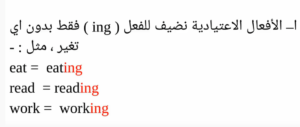
للتعرف على الافعال عند إضافة ing للأفعال
ا– الأفعال الاعتيادية نضيف للفعل ( ing ) فقط بدون اي تغير ،
مثل : –
eat = eating يأكل
read = reading يقرأ
work = working يعمل
ب – إذا كان الفعل منتهيا ب ( e ) صامت فعند اضافة ( ing )
نحذف ( e ) , مثل
take = taking يأخذ
write = writing يكتب
move = moving يتحرك
come = coming يأتي
قواعد اضافة ing للأفعال
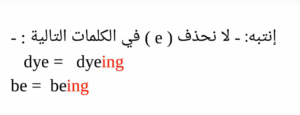
إنتبه: – لا نحذف ( e ) في الكلمات التالية : –
dye = dyeing يصبغ
be = being يكون
إذا كان الفعل منتهي ب (ee )
لا نحذف اي حرف ، مثل : –
agree = agreeing يوافق
see = seeing يرى
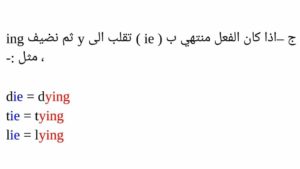
ج –اذا كان الفعل منتهي ب ( ie )
تقلب الى y ثم نضيف ing ، مثل :-
وفاة die = dying يموت
tie = tying يربط
lie = lying يضطجع
قواعد اضافة ing للأفعال
د – إذا كان الفعل مكون من مقطعين ومنتهي ب ( l )
نضاعف حرف l
travel = travelling يسافر
control = controlling يتحكم
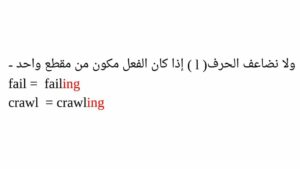
ولا نضاعف الحرف( l ) إذا كان الفعل مكون من مقطع واحد
fail = failing يفشل
crawl = crawling يزحف
هـ – اذا كان الفعل ينتهي بحرف صحيح وقبله حرف علة واحد ،
يجب مضاعفة الحرف الصحيح الأخير عند إضافة ( ing ) مثل :-
sit = sitting يجلس
stop = stopping يتوقف
plan = planning يخطط
beg = begging يتضرع
swim = swimming يسبح
cut = cutting يقطع
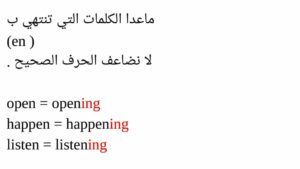
ماعدا الكلمات التي تنتهي ب ( en )
لا نضاعف الحرف الصحيح .
open = opening يفتح
happen = happening يحدث
listen = listening يستمع
قواعد اضافة ing للأفعال
لا نضاعف الحرف إذا جاء قبلها حرف عله .
play = playing يلعب
fix = fixing يثبت
grow = growing ينمو
قواعد اضافة ing للأفعال
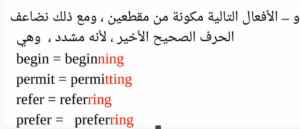
و – الأفعال التالية مكونة من مقطعين ،
ومع ذلك نضاعف الحرف الصحيح الأخير ،
لأنه مشدد ، وهي
begin = beginning يبدأ
permit = permitting يسمح
refer = referring يشير
prefer = preferring يفضل
occur = occurring يقع
regret = regretting يندم
forbid = forbidding يمنع
لتحميل الدرس بصيغة pdf
قواعد اضافة ing في اللغة الانجليزية وفي الكلمات الانجليزية
قواعد اضافة ing في اللغة الانجليزية وفي الكلمات الانجليزية
اليوم سوف نتعرف على قواعد اضافة ing في اللغة الانجليزية وفي الكلمات الانجليزية . بسم الله والصلاة وسلام على رسول الله اما بعد ، احبتي متابعي مدونة تعليم اللغة الانجليزية للمبتدئين ، احبتي في الله اليوم بحول الله وحفظه في قسم الخاص بقواعد اللغة الانجليزية سوف نتحدث في درس سوف يكون مهم جدا لكل من يرغب في أن يدرس و يتعلم اللغة الانجليزية عبر قواعد انجليزية التي تحمل
معها عدد كبير من القواعد التعليمية والمفيدة في مسار تعلمك للغة الانجليزية ، كما ان القواعد في الانجليزية تكون سببا في تنمية مهارات الشخص في تعلم اي لغة اجنبية أو عربية .
سوف نتعرف على أمر جدا مهم لا يقل أهمية عن الدروس السابقة و القواعد التي تعرفنا عليها وهذا الموضوع عن القواعد الكتابية والاملائية لهذا الزمن أو القاعدة وكيف يمكن إضافة ing في نهاية الكلمات الانجليزية حيث أنه لا تتضاف الـ ing هكذا وحسب إلى الكلمة بل هناك قواعد سوف نتعرف عليها بإذن الله في هذا الدرس .
وفي اللغة الانجليزية يبدو أنه من الممكن أن تستخدم قاعدة ing لأي شيء في الإنجليزية لكن هنالك طرق محددة لاستخدامها في مواضع مختلفة في الجمل و الكلمات ، سنتعرف فيما يلي على كيفية ومتى تستخدم هذه القاعدة في كلمات اللغة الإنجليزية .
قواعد اضافة ing في اللغة الانجليزية :
– تضاف ing في الفعل لتكوين زمن المضارع المستمر و الماضي المستمر و المستقبل المستمر و التام المستمر في كلمات اللغة الانجليزية .
– و اذا كان الفعل القياسي في الجملة الانجليزية منتهيا ب e فعند اضافة ing لذلك الفعل القياسي يحذف e مع العلم أن هذه القاعدة تنطبق على الأفعال الشادة في اللغة الانجليزية .
– هناك أفعال لا يحذف فيها e و منها عندما يضاف اليها ing ، هذه القاعدة الخاصة بالأفعال تطبق عندما يضاف اليها ed في الكلمات الانجليزية .
– الفعل القياسي اذا كان منتهيا y و كان y مسبوقا بحرف من حروف العلة أو بحرف صحيح فانه لا يتغير y عند اضافة ing له .
– الفعل القياسي اذا انتهى بحرف صحيح و كان قبله حرف علة و كان الفعل في الانجليزية متكونا من مقطع واحد فان الحرف الصحيح الأخير يتضاعف عند اضافة ing اليه .
– تضاف ing للأفعال ولكن بشروط محددة، عندما تكون الجملة في كل من الأزمنة التالية ( الحاضر المستمر والتام المستمر – الماضي المستمر والتام المستمر – المستقبل المستمر والتام المستمر) ، أو لتحويلها إلى اسم أو صفة في بعض الكلمات مثل :
(صفة) مفقود missing — يفتقد miss
(اسم) شعور feeling — يشعر feelشاهد ايضا
– إذا كانت الكلمة منتهية بـ e يسبقه حرف ساكن:
عند إضافة ing نحذف e ونضيف .ing مثل: يأتي come — coming
باستثناء الفعل be — being
– إذا كانت الكلمة منتهية بـ ie :
عند إضافة ing نحذف ie ونضيف .ying مثل: يكذب lie — lying
– إذا كانت الكلمة منتهية بحرف ساكن + حرف صوتي + حرف ساكن، وكان نطْق الحرف الأخـير مـن الكلمة بعد إضافة ing مشدد “في هذه الحالة يجب أن تحفظ لفظ المفردات”.
عند إضافة ing- نضعف الحرف الأخير من الكلمة ثم نضيف ing- مثل :
run — running يجري ، stop — stopping يتوقف ، plan — planning يخطط .
وفي الأخير أشكر كل من أكمل قراءة هذه المقالة الى الآخر التي تعرفنا فيها على قواعد اضافة ing في اللغة الانجليزية وفي الكلمات الانجليزية ، أتمنى أن تشاركوا هذا الموضوع مع الأصدقاء وفي المجموعات على الفيسبوك أو الواتس أو أي وسيلة للتواصل الاجتماعي المهم هو نشرها على أوسع نطاق لتعم الفائدة ، و السلام عليكم و رحمة الله وبركاته .
شرح قواعد إضافة ING للأفعال في اللغة الانجليزية بالتفصيل مع الأمثلة
شرح قواعد إضافة ING للأفعال في اللغة الانجليزية بالتفصيل مع الأمثلة
سوف نتعرف على أمر جداً مهم لا يقل أهمية عن معرفتنا لزمن المضارع المستمر Present Continues أو Present Progressive .. وهو القواعد الكتابية والإملائية لهذا الزمن , وكيف يُمكن إضافة ing في نهاية الكلمات حيثُ أنه لا تُضاف الـ ing هكذا وحسب إلى الكلمة , بل هناك قواعد سوف نتعرف عليها بإذن الله, استفساراتكم وتعليقاتكم وملاحظاتكم مُرحبٌ بها كالعادة .. ودعواتكم لنا عن ظهر الغيب ولوالدينا ..
إضافة ING وقواعدها الإملائية
عندما نأتي إلى جملة في زمن المضارع المستمر Present continues كالتالية:
- Ali is studying English.
- علي يدرس اللغة الإنجليزية
لاحظ أن الفعل في زمن المضارع المستمر Study تم فقط إضافة الـ ing له دون تعقيدات (وهو ما يغلب على بقية الكلمات) ..وهو ما تُسمى بالأفعال الأساسية أو الـ Base verbs
إلا أنه علينا معرفة بقية القواعد وهي كالتالي:
أفعال تنتهي بـ E– صامتة ، (أي لا تُلفظ) || VERBS END WITH A SILENT -E
Example:
abide, abuse, accede, accelerate, accentuate, accommodate, accumulate, accuse, ache, achieve, acknowledge, acquiesce, acquire, activate, actuate, adduce, adhere, adjudicate, admire, adore, advance, adventure, advertise, advise, advocate, aerate, age, agglomerate, aggravate, agitate, agree, alienate, allege, alleviate, allocate, alternate, amaze, amortize, amuse,
, angle, annihilate, announce, antagonize, anticipate, apologize, appease, appraise, appreciate, appropriate, approve, approximate, arbitrate, argue, arise, arose, arouse, arrange, arrive, arrogate, articulate, ascribe, aspire, assemble, assimilate, associate, assume, assure, ate, atone, attribute, authenticate, authorize, automate, avenge, average, awake, awoke.
الإجراء المتبع:
لاحظ أن الأفعال السابقة لا تُلفظ فيها الـ -e وهي تُعتبر صامتة
[ والإجراء المتبع هو بحذف الـ –e الأخير وإضافة ing ]
abiding, abusing, acceding , …etc
لا تنس الاستعانة بأدوات ترجمة مثل مُترجم قوقل لترجمة الكلمات ومعرفة المعاني
أفعال تنتهي بـ –EE , -YE- وَ OE
هناك أفعال عددها يُعد على الأصابع لا نقوم بحذف الـ –e الأخير عند إضافة ing وذلك لتمييزها عن كلمات مشابهة (
مثلاً:
signe تصبح signeing ولو لم نحذف الـ –e الأخيرة لأصبحت signing (المضارع المستمر من sing والتي تعني الغناء )
أفعال تنتهي بحرف متحرك ثم حرف الـ L
إن كان الفعل ينتهي بحرف علة Vowel ويليه حرف (L) كأفعال مثل (Travel) وَ ( Equal ) نقوم بمُضاعفة حرف الـ l الأخير ، ونقوم بإضافة ing ، وهذا ينطبق على الإنجليزية البريطانية، [ حيثُ أن الإنجليزية الأمريكية لا تقوم بمضاعفة حرف l … ]
- equal تُصبح بعد إضافة ing = هكذا equalling
- Travel تُضبح بعد إضافة ing = هكذا travelling
- distil تُصبح بعد إضافة ing = هكذا distilling ..
- fuel تُصبح بعد إضافة ing = هكذا fuelling …
حروف العلة أو vowel وهي خمسة حروف (a,e,i,o,u)
إن كان الفعل ينتهي بـ حرف ثابت + علة + ثابت وهو اختصار لـ CVC نقوم بمضاعفة الحرف الثابت الأخير ونقوم بـ إضافة ING
أمثلة : (هذه الأفعال ذو مقطع صوتي واحد)
- stop تصبح بعد إضافة ing هكذا = stopping
- sit تصبح بعد إضافة ing هكذا = sitting
- plan تصبح بعد إضافة ing هكذا = planning
الحروف الثابتة هي كل الحروف ما عدا حروف العلة الخمسة (a,e,i,u,o)
وهي تعني بالإنجليزية consonant وحروف العلة تعني vowels
إن كان الفعل ينتهي باحتوائه على مقطعين وكانا CVC (ثابت + علة + ثابت) نقوم بـ إضافة ING دون أية مضاعفات لأي حرف
وحتى نشرح هنا ماذا نعني بـ مقطعين , لاحظ الفعل [ happen ] يمكن أن نلاحظ عند لفظنا للفعل أنها تحتوي على مقطعين فتكون [ hap pen ] .. حاول تلفظون الفعل للمقطع الأول ثم تتوقفوا ثم تلفظو المقطع الثاني, أرأيتم ..هكذا يكون مقطعين ..واعتبر كل مقطع لوحده لاحظ الـ CVC (حرف ثابت + علة + ثابت ) كما أن المقطع الثاني نفس الأمر (حرف ثابت + علة + ثابت ) ..*
فتكون إضافة ing بهذه الطريقة = happening (دون أية مضاعفات )
هذه المعلومات بخصوص المقاطع الصوتية قد تكون متقدمة للطلاب في دراسات متقدمة, حيثُ لها دراسة خاصة فيما يُسمى “علم النطق” ..لن نُبحِر كثيرا ً ونعقدها على من هم في المستوى “المرحلة الثانوية والمتوسطة”.. ولكن لا يزال بإمكانك البحث والسؤال (سؤال معلم اللغة الإنجليزية الخاص بك) للاستفادة من أي معلومات قد تكون ناقصة لديك .
أفعال تنتهي بـ IE ، نقوم باستبدالـ IE بـ Y ثم نقوم بـ إضافة ING
هناك أفعال تنتهي بـ ie مثلاً lie وَ die .. جربوا إضافة ing … ستجدونها غير صحيحة
- lieing << خطأ والصواب حذف الـ ie ووضع y ثم إضافة ing فتصبح هكذا = lying
- dieing << خطأت والصواب حذف الـ ie ووضع y ثم إضافة ing فتصبح هكذا = dying
الفعل المضاف له ing والمصدر
يوجد شكلين مختلفين للفعل عن الشكل المعتاد له مع كل زمن في اللغة الإنجليزية، الشكل الأول هو الفعل بالمصدر أي دون إضافات على الفعل والشكل الثاني هو الفعل بالمصدر ثم إضافة ing في نهاية الفعل، نتحدث في هذا الدرس متى نستخدم كل منهما ومواقعهم في الجمل.
الفعل المضاف له Gerunds – ing
يكون شكل الفعل كالآتي: verb + ing.
غالباً نستخدم هذا الشكل من الأفعال عند حدوث الفعل قبل أو في نفس وقت حدوث الفعل الرئيسي في الجملة، مثال: I enjoy cooking أي أنا استمتع بالطبخ. فأنا أطبخ واستمتع بالطبخ في نفس الوقت.
هناك أفعال معينة يأتي بعدها gerund في الجمل أو بعض أحرف الجر أو بعض التعابير.
1- بعد الأفعال الحسية:
| يعجب | Like |
| يحب | Love |
| يستمتع | Enjoy |
| ينفر / لا يحب | Dislike |
| يكره | Hate |
2- بعد بعض الأفعال:
| يعترف | Admit |
| يسمح | Allow |
| ينكر | Deny |
| ينتهي | Finish |
| يذهب | Go |
| يتخيل | Imagin |
| يُبقي | Keep |
| يمارس | Practice |
| يقترح | Suggest |
3- بعد بعض أحرف الجر:
| قبل | After |
| بعد | Before |
| مهتم بـ | Interested in |
| يستمر في | Keep on |
| جيد في | Good at |
4- بعد بعض التعبيرات:
| أتطلع إلى | Look forward to |
| لا أطيق/أحتمل | Can not help/stand |
| لا يوجد فائدة من | It is no use |
| هل تمانع أن | Would you mind |
5- عند بدء الجملة بـ gerund:
مثال:
Watching TV for a long time is harmful to your eyes.
مشاهدة التلفاز لوقت طويل مؤذٍ للعين.
أمثلة:
| أستمتع بلعب كرة القدم. | I enjoy playing football. |
| أحب مشاهدة الأفلام. | I like watching movies. |
| هي تتجنب مقابلة صديقها. | She avoids meeting her friend. |
| أنت ذكرت العمل في البنك مسبقاً. | You mentioned working in the bank earlier. |
| هو مهتم بالسفر. | He is interested in traveling. |
| بعد تناول الطعام في المطعم ذهبنا إلى منزلنا. | After eating in the restaurant, we went home. |
| لا فائدة من استبدال السيارة. | It is no use replacing the car. |
| لا يوجد جدوى من تغيير القفل. | There is no point in changing the lock. |
المصدر – Infinitives
يكون شكل الفعل كالآتي: to + verb مع الانتباه إلى عدم وجود أي إضافات على الفعل.
غالباً نستخدم هذا الشكل من الأفعال عند حدوث الفعل بعد وقت حدوث الفعل الرئيسي في الجملة، مثال:
I want to go home أريد العودة إلى المنزل أي أنا أذهب للمنزل بعد رغبتي بالذهاب.
يأتي الفعل بالمصدر infinitive في الجمل بعد أفعال مستقبلية أو صفات أو بعض الظروف.
1- بعد الأفعال التي تشير إلى حدث مستقبلي:
| يهدف | Aim |
| يختار | Choose |
| يقرر | Decide |
| يعرض – يقدم | Offer |
| يعد – يعطي وعد | Promise |
| يريد | Want |
2- بعد الصفات:
| خائب الأمل | Disappointed |
| ممتن | Glad |
| مسرور | Pleased |
| سعيد | Happy |
3- بعد بعض الظروف والتعابير:
| جداً | Too |
| كفاية | Enough |
| الأخير | The last |
| الأول | The first |
4- عند شرح سبب قيام شخص ما بعمل شيء ما:
مثال:
I work to earn experience.
أنا أعمل لكي أكتسب خبرة.
أمثلة:
| أريد أن أقول لك شيئاً. | I want to tell you something. |
| هو يحتاج للعثور على عمل. | He needs to find a job. |
| أنا مسرور بلقائك أخيراً. | I am glad to finally meet you. |
| هي حزينة لسماع الأخبار السيئة. | She is sad to hear the bad news. |
| إنه صعب جداً العمل في المكتب. | It is too hard to work in the office. |
| إنه مريح كفاية الجلوس على هذا الكرسي. | It is comfortable enough to sit on this chair. |
ملاحظات:
1- بعد الأفعال الحسية يمكن كتابة الفعل بالمصدر ويعتبر صحيح قواعدياً ولكن الأفضل هو استخدام الفعل المضاف له ing.
مثال: أحب الذهاب إلى حوض السباحة في الصيف.
I like to go/going to the pool in the summer.
2- هناك بعض الأفعال التي يمكن استخدام gerunds أو infinitives بعدها.
مثل:
| يبدأ | Start |
| يوقف | Stop |
| يتذكر | Remember |
| يبدأ | Begin |
I stopped smoking.
I stopped to smoke.
لكن يوجد اختلاف في المعنى:
الجملة الأولى تعني أقلعت عن التدخين.
الجملة الثانية تعني توقفت (في مكان ما) كي أدخن.
هذا كل ما يتعلق بدرس المصدر والأفعال المضاف لها ing والفرق بينهما واستخداماتهم في اللغة الإنجليزية. في حال وجود أي استفسار أو اقتراح يمكنكم مشاركته معنا في قسم التعليقات أدناه.
Exercise:
Complete the following sentences with the correct form of the verbs, whether it is infinitive or gerund
أكمل الجمل التالية بالصيغة الصحيحة للأفعال سواء كانت infinitive أم gerund.
1- She wants …. to another place. (move)
2- I imagine …. to every country. (travel)
3- The first one …. the meal is the winner. (finish)
4- He likes …. pizza. (eat)
5- They offered …. us. (help)
6- John is interested in …. math. (study)
7- I ask her …. the dishes. (wash)
8- Leila keeps on …. for too many hours. (work)
The answers:
1- She wants to move to another place.
2- I imagine traveling to every country.
3- The first one to finish the meal is the winner.
4- He likes eating pizza.
5- They offered to help us.
6- John is interested in studying math.
7- I ask her to wash the dishes.
8- Leila keeps on working for too many hours.

